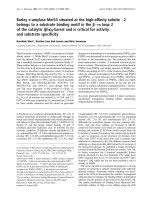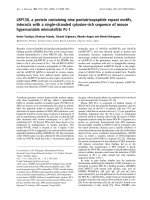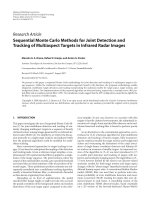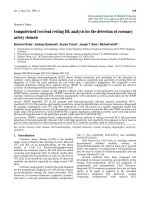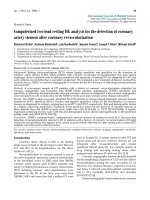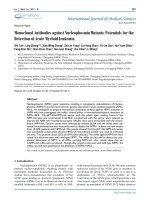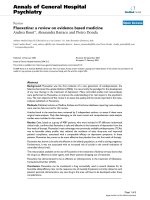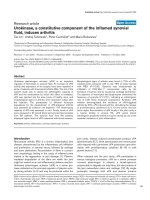Báo cáo y học: "yrGATE: a web-based gene-structure annotation tool for the identification and dissemination of eukaryotic genes" pdf
Bạn đang xem bản rút gọn của tài liệu. Xem và tải ngay bản đầy đủ của tài liệu tại đây (450.86 KB, 11 trang )
Open Access
Volume
et al.
Wilkerson
2006 7, Issue 7, Article R58
Software
Matthew D Wilkerson*, Shannon D Schlueter* and Volker Brendel*†
comment
yrGATE: a web-based gene-structure annotation tool for the
identification and dissemination of eukaryotic genes
Addresses: *Department of Genetics, Development and Cell Biology, Iowa State University, Ames, IA 50011-3260, USA. †Department of
Statistics, Iowa State University, Ames, IA 50011-3260, USA.
Correspondence: Volker Brendel. Email:
Received: 24 April 2006
Revised: 8 June 2006
Accepted: 5 July 2006
Genome Biology 2006, 7:R58 (doi:10.1186/gb-2006-7-7-r58)
reviews
Published: 19 July 2006
The electronic version of this article is the complete one and can be
found online at />
reports
© 2006 Wilkerson et al.; licensee BioMed Central Ltd.
This is an open access article distributed under the terms of the Creative Commons Attribution License ( which
permits unrestricted use, distribution, and reproduction in any medium, provided the original work is properly cited.
yrGATE is a annotation tool
A gene-structurenew web-based tool for community gene and genome annotation.
Abstract
A policy of 'open annotation', using the internet as the forum
for annotation, and bringing annotation into the mainstream
has been suggested as a means to eliminate the restraints of
manual annotation and to develop high quality gene annotation [13-15]. Several systems have successfully adopted this
policy for prokaryote gene annotation (ASAP [16], PeerGAD
Genome Biology 2006, 7:R58
information
Gene structure determination is particularly difficult for
eukaryotic genomes. Here, we focus on protein-coding genes.
In higher eukaryotes, most of these genes contain introns,
and a large fraction of the genes appear to permit alternative
splicing [1-3]. High-throughput computational gene structure annotation has been highly successful in providing a first
glimpse of the gene content of a genome, but current methods
fall short of the goal of complete and accurate gene structure
annotation (for example, [4-6]). Recent research has focused
on improving prediction sensitivity and specificity by combining multiple sources of evidence [7-9]. However, complexities of transcription and pre-mRNA processing, such as
introns in non-coding regions, non-canonical splice sites, and
utilization of alternative splice sites, still pose formidable
challenges for merely computational methods. Re-annotation
efforts for most eukaryotic model genomes have, therefore,
relied in large part on manual inspection of gene structure
evidence [5,10,11]. However, manual annotation also has
shortcomings, such as being typically time-consuming, having exclusive participation, and providing annotations only
intermittently [4,10,12].
interactions
Complete and accurate gene structure annotation is a prerequisite for the success of many types of genomic projects. For
example, gene expression studies based on gene probes
would be misleading unless the gene probes uniquely labelled
distinct genes. Identification of potential transcription signals relies on correct determination of transcriptional start
and termination sites. Characterization of orthologs or paralogs and other studies of molecular phylogeny are also compromised by incomplete or inaccurate gene structure
annotation.
refereed research
Rationale
deposited research
Your Gene structure Annotation Tool for Eukaryotes (yrGATE) provides an Annotation Tool and
Community Utilities for worldwide web-based community genome and gene annotation.
Annotators can evaluate gene structure evidence derived from multiple sources to create gene
structure annotations. Administrators regulate the acceptance of annotations into published gene
sets. yrGATE is designed to facilitate rapid and accurate annotation of emerging genomes as well
as to confirm, refine, or correct currently published annotations. yrGATE is highly portable and
supports different standard input and output formats. The yrGATE software and usage cases are
available at />
R58.2 Genome Biology 2006,
Volume 7, Issue 7, Article R58
LOCAL DATABASE
Wilkerson et al.
DAS SERVER
GENOME SEQUENCE
EXON EVIDENCE
EXON REFERENCES
INPUT
ANNOTATION TOOL
GENE STRUCTURE
PROTEIN CODING REGION
MRNA & PROTEIN SEQUENCES
EVIDENCE ATTRIBUTES
DESCRIPTION
FUNCTIONAL INFORMATION
OUTPUT
LOCAL DATABASE TEXT FILE
GFF3
Figure 1
The applications interface of yrGATE
The applications interface of yrGATE. Input to yrGATE is derived from
either local database tables or distributed DAS sources. Output is either
to local database tables or in the form of simple text or GFF3 files.
[17], PseudoCAP [18]). Eukaryotic gene annotation projects
have not been able to reap the full benefits of community
manual annotation because of the absence of an open online
community gene annotation system. Here, we describe newly
developed software, Your Gene structure Annotation Tool for
Eukaryotes (yrGATE), which seeks to compensate for the
inadequacies of traditional manual annotation and to provide
a community alternative and/or companion to computational
gene annotation, specialized for eukaryotes. yrGATE provides
similar functionality as the Apollo annotation tool [19] and
NCBI's ModelMaker [20], but includes community utilities,
specialized portals to external gene finding and annotation
software, and web browser accessibility.
/>
The yrGATE package consists of a web-based Annotation
Tool for gene structure annotation creation and Community
Utilities for regulating the acceptance of the annotations into
a community gene set. The yrGATE Annotation Tool can be
used without the Community Utilities for analysis of gene loci
independent of a community. The Annotation Tool presents
pre-calculated exon evidence in several summaries with different selection mechanisms and provides other methods for
specifying custom exons, allowing thorough analysis and
quick annotation of loci. Annotators access the tool over the
web, where they create an annotation, decide to save the
annotation in their personal account, or submit the annotation for review for acceptance into the community gene set.
The online nature of yrGATE permits a large and nonexclusive group of annotators, ranging in expertise from professional curators to students [21]. This also provides a
continuous timeframe for gene annotation, allowing annotators to examine new sequence evidence as it becomes available and eliminating the delays of periodic annotation.
yrGATE is particularly well suited for emerging genomes that
are in the process of being sequenced, such as maize. Additionally, the user-friendly character of the yrGATE system
contributes to its accessibility and to its potential for community adoption.
Annotation tool
The Annotation Tool of the yrGATE package is a web-based
utility for creating gene structure annotations. The inputs and
outputs of the Annotation Tool are depicted in Figure 1. The
input consists of a genomic sequence, exon evidence, and evidence references. The output of the Annotation Tool is a gene
annotation, which consists of a gene structure (coordinates of
exons and introns), the inferred mRNA sequence, a corresponding protein coding region and its associated translation
product, evidence attributes, description, and functional
information. The input and output can be in several formats
(indicated in Figure 1), which will be described in detail in the
Implementation section below.
Defining a gene's exon-intron structure is the central step in
creating a eukaryotic gene annotation. The Annotation Tool
provides two general categories to specify exons: pre-defined
evidence-supported exons and novel user-defined exons. Predefined exons are provided by the Annotation Tool from prior
computations and are supported by evidence derived from
spliced alignments of expressed sequence tags (ESTs) and
cDNAs, ab initio predictions, or a combination of sources.
The evidence is filtered by stringent thresholds to provide
exons suggestive of authentic genes. User-defined exons are
exons not contained in the pre-defined evidence and are individually specified by the user. Annotators have several channels to designate both categories of exons.
The Annotation Tool contains three representations of the
evidence: the Evidence Plot, the Evidence Table, and links to
Genome Biology 2006, 7:R58
/>
Genome Biology 2006,
To document the annotator's procedure and parameters, the
Exon Origins attribute of an annotation record automatically
stores information about the source of each exon. The following information is stored: the method of exon-generation, a
score associated with the method and exon, sequence identifiers used in the method, unique database identifiers to the
specific output file or record, and a hyperlink to the program
output yielding the exon. Exon Origins allows for complete
re-creation of the gene structure annotation and for analysis
of manual annotation procedures that could aid in future
manual annotation efforts and techniques.
After a gene structure has been defined, a user can specify the
protein coding region of the annotation through entry of
genomic coordinates (4 in Figure 2a) or by using the ORF
Finder [20] portal. The ORF Finder portal (Figure 2b), operating similarly to the User Defined Exons portals, allows a
user to select an open reading frame, which upon selection is
imported into the Annotation Tool window and is graphically
represented in the Preview Structure.
interactions
Figure 2 (see following
Novel gene annotation page)
Novel gene annotation. This yrGATE implementation at ZmGDB presents the region 158659-162032 of Zea mays BAC gi 51315585. (a) The main
Annotation Tool window contains a completed gene structure annotation. The provided transcript evidence consists of two groups of ESTs (9, circled)
separated by a region with no spanning evidence, 160260-160664 (8). User defined exons have been designated in this region. The User Defined Exons
Table (2) lists each exon by coordinates and source. (b) Exon 5, 160575..160721, was defined using portals to (b) GENSCAN and GeneSeqer@PlantGDB
(not shown). Yellow buttons in the GENSCAN portal (b) add exons to the gene structure in the Annotation Tool (6 in panel a), which are presented
pictorially (10 in panel a) for comparison with the Evidence Plot. A protein-coding region was evaluated using the portal to the (c) ORF Finder and
imported into the Annotation Tool (4 in panel a) using the yellow button.
refereed research
For cases in which genomic sequence requires editing, such as
correction of sequencing errors or annotation of genes undergoing mRNA editing, the Sequence Editor Tool (7 in Figure
2a) enables annotators to insert, delete, or change bases
through a web interface. These changes are incorporated into
the Annotation Tool and stored with the annotation record.
deposited research
Coordinately with gene structure and protein coding region
designation and edits, the mRNA and protein sequence fields
are updated (3 and 5 in Figure 2a). Hyperlinks, attached to
the appropriate sequence, are provided to BLASTN,
TBLASTX, BLASTX, TBLASTN and BLASTP at NCBI [20] for
an annotator to find similar sequences and/or assign a putative function. Additional pieces of information that can be
added to a gene annotation are a description and alternative
identifiers.
reports
As an additional channel provided for designating gene structures, the tool allows pasting a coordinate structure into the
mRNA structure field (6 in Figure 2a). The format for specifying an mRNA structure follows the conventional notation of
designating exons by start and end coordinates separated by
non-digits, with multiple exons separated by commas (for
example, the Perl regular expression for a two-exon gene
structure is [\d+\D+\d+,\d+\D+\d+]). This channel is
appropriate for comparing external gene structures with the
evidence. Exons not found in the pre-defined evidence are
given an 'unknown' source in the User Defined Exons table.
reviews
User-defined exons are specified through portals to exongenerating programs or through entry of the genomic coordinates of an exon. As these exons are defined, they are listed in
the User Defined Exons Table (2 in Figure 2a). Acting as a
type of web service, portals deliver the genome sequence of
the annotation region to an online exon-generating program,
with appropriate default parameters specified while allowing
the user to change these parameters. The program's output is
internally reformatted such that the user can directly add
exons from the program's output window into the current
gene structure displayed in the yrGATE Annotation Tool window. Currently, portals are available to the gene prediction
programs GENSCAN [22] and GeneMark [23] and to the
GeneSeqer spliced alignment web server [24]. Administrators
can easily add new portals for other exon-generating programs or sequence analysis programs, such as folding programs for non-coding RNA annotations. A template portal is
provided with the package.
Wilkerson et al. R58.3
comment
evidence reference files. The Evidence Plot is a clickable
graphic that presents evidence in a color-coded schematic (8
in Figure 2a). The Evidence Table (11 in Figure 2a) groups
exons into mutually exclusive groups of exon variants. For
each exon, the table lists its genomic coordinates, the maximum score from the method that generated the exon, and the
evidence sources that support the exon. The evidence identifiers are hyperlinked to reference files for the exon, which
could be an alignment or other program output. Annotators
can select pre-defined exons by clicking on exon diagrams in
the Evidence Plot or clicking on buttons in the Evidence
Table. The annotator's developing gene structure is graphically displayed below the Evidence Plot for visual comparison
(10 in Figure 2a).
Volume 7, Issue 7, Article R58
information
Genome Biology 2006, 7:R58
R58.4 Genome Biology 2006,
Volume 7, Issue 7, Article R58
Wilkerson et al.
/>
(a)
yrGATE : Gene Structure Annotation Tool
Zea mays (ZmGDB)
1
Submit
Remove Annotation
Annotation Owned By: mwilkers
Gene Annotation Id
Save for Editing
Export to Text
Evidence Plot (color legend) change image size to 400
158600
159600
160100
160600
1 6 11 0 0
74244284
forward
reverse strand
32921298
71435182
Reset mRNA structure
71435181
89248560
Portals
GeneSeqer at PlantGDB
159981 160344
(GeneSeqer)
160444 160488
(GeneSeqer)
7 8 11 9 6 0 5
71441960
start
160575 160721
(GeneSeqer,GENSCAN)
32859895
89252088
GeneMark GENSCAN
Manual Entry
8
161600
7145129
7 8 11 9 6 0 6
User Defined Exons
2
159100
end 162032
Change Location
Strand
Reset
Annotation Record Status: new annotation - not saved
yrGATE-ZM-sugar_transporter
Genome Location
Genome Segment 51315585
start 158659
Export to GFF
91056537
9
10
Your Structure:
end
add
Clear User-Defined Exons Table
Evidence Table
mRNA (2072 nucleotides)
3
CTCCCCCTTTGCCCCGTGAGGCCGTGACTCGGCGACGGAGAAGAC
AAACCATGACGCCTCCCGGCCAACTGCTCCCCTTGTCCCGGCTGC
CTCCCGGCCTCTCCAGCCGCTGCCCGCCTCCCGCTCATGCCCAAG
CCAGAGTGTCGCTTCTGCATCCATGGGCCCACCGCCTCCATGGCC
GCTTCATGCCTTCTCCTCATCTGTTCCGGTCTCCAGCCTGCCCCC
CTCGTGCTCCAACGCCTCCAGGGCTTTCGGCCGCCGCAGGAGGCG
only display selected exons
Exon Coordinates
Score
Evidence supporting exon
158659 159101
1
158664 159101
1
78119606
blastn blastx tblastx
158672 159101
1
71435182
Protein Coding Region
Start 158709
end 161543
158794 159101
1
71306541 71441960
159619 159708
1
78119606
159619 159845
1
71306541 74244284 71441960
71435182
159981 160058
1
71435182
159981 160086
0.991
71306541
159981 160143
1
74244284
159981 160260
0.979
71441960
160664 160721
1
7145129
160688 160721
1
32921298
160692 160721
1
71435181
161003 161140
1
7145129 71435181 32921298
161120 161140
4
1
32859895
161234 161267
1
7145129 71435181 32859895 32921298
1
ORF Finder
2
Protein (510 amino acids)
5
MTPPGQLLPLSRLPPGLSSRCPPPAHAQARVSLLHPWAHRLHGRF
MPSPHLFRSPACPPRAPTPPGLSAAAGGEAQAAAVAEFVTSERVK
VAAMLGLALALCNADRVVMSVAIVPLSQAYGWTPSFAGVVQSSFL
WGYLMSPIIGGALVDYYGGKRVMAYGVALWSLATFLSPWAAGRSI
WLFLFTRVLLGIAEGVALPSMNNMVLRWFPRTERSSAVGIAMAGF
QLGNTIGLLLSPIIMSRTGIFGPFVIFGLFGFLWVLVWIPAISGT
3
blastp tblastn
mRNA Structure
6
join(158659..159101,159619..159845,159981..
4
protein coding gene
Gene Annotation Type
Genome Sequence Edits
7
11
74244284
5
Genome Sequence Editor
6
(b)
(c)
yrGATE Portal to NCBI ORF Finder
yrGATE Portal to GENSCAN
click on yellow
buttons to add
exons
Organism:
Arabidopsis
GENSCAN
Select ORF for Annotation
GENSCANW output for sequence 12:55:02
GENSCAN 1.0
Date run: 30-May-106
ORF Finder (Open Reading Frame
Finder)
(magenta ORF is the current
selection)
Time: 12:55:02
coordinates of ORF are relative to
transcript
Sequence 12:55:02 : 3374 bp : 43.72% C+G : Isochore 2 (43 - 51 C+G%)
Parameter matrix: Arabidopsis.smat
PubMed
Predicted genes/exons:
Program blastp
Gn.Ex Type S .Begin ...End .Len Fr Ph I/Ac Do/T CodRg P.... Tscr..
----- ---- - ------ ------ ---- -- -- ---- ---- ----- ----- ------
View
1.01 Intr +
158905
1.02 Intr +
159619
159101
159845
197
2
227
2
0
2
95
51
19
55
303 0.669
28.23
81 0.840
2.88
Add Exon to Annotation
Add Exon to Annotation
160143
163
0
1
82
38
55 0.380
4.88
Add Exon to Annotation
1.04 Intr +
160575
160721
147
2
0
56
89
36 0.473
5.93
Add Exon to Annotation
1.05 Intr +
161003
161024
22
1
1
86
72
18 0.545
2.12
Add Exon to Annotation
1.06 Term +
161359
161543
185
2
2
76
43
52 0.192
2.21
Add Exon to Annotation
1.07 PlyA +
161859
161864
6
1.05
Add Exon to Annotation
1.03 Intr +
159981
Entrez
BLAST
OMIM
Taxonomy
Structure
Anonymous
Figure 2 (see legend on previous page)
Genome Biology 2006, 7:R58
Database nr
1 GenBank
Redraw
with parameters
50
Frame from to Length
+3
51..1583 1533
-2 1151..1540 390
-3 1696..2040 345
+2
158.. 499 342
-2
725..1024 300
-1
3.. 278 276
127.. 303 177
+1
-3
1.. 159 159
/>
Genome Biology 2006,
Genome Biology 2006, 7:R58
information
The first case study is a novel maize annotation using the
ZmGDB yrGATE implementation. An unannotated genome
region, 158659-162032 of BAC 51315585, was chosen by the
annotator using the genome browsing function of ZmGDB. A
screenshot of the Annotation Tool shows the completed
annotation (Figure 2). Exons were initially selected from the
pre-computed evidence. The evidence, though, consists of
two separate groups of ESTs (9 in Figure 2a) with no spanning
evidence in the region 160260-160664. The annotator
decided to use the GENSCAN and the GeneSeqer@PlantGDB
portals to explore potential exons in this region (2 in Figure
2a). After adding three user defined exons, a gene structure
connecting both groups of ESTs was defined (6 and 10 in Figure 2a). The portal to the ORF Finder was used to define a
protein-coding region, which spanned all eight exons of the
putative transcript. Terminal exons, supported by ESTs
71435182 and 32859895, were selected to maximize the
untranslated regions. The final step of the annotation session
was a BLASTP search at NCBI to compare the novel gene
annotation and to assign a putative gene product function.
The protein of the annotation had high similarity over most of
its length to rice protein NP_915525 and to Arabidopsis protein NP_190282. These proteins provided a putative functional assignment of 'sugar transporter' for the annotation.
The annotator was satisfied with the annotation and submitted it for review. Administrators reviewed the annotation and
accepted it because it was novel and of good quality. The
interactions
For specific implementations, the described community
annotation process can be adjusted by dropping any of the
steps, such as eliminating the user log in or eliminating the
review process so that all submitted annotations are published. New steps can also be added to the review process,
such as a voting utility for submitted annotations.
PlantGDB includes a family of species-specific databases:
AtGDB [26,27] for Arabidopsis, ZmGDB [28] for maize, and
OsGDB [29] for rice. These species-specific databases each
have an annotation community and an implementation of
yrGATE. Input to the yrGATE annotation tool is supplied by
the respective PlantGDB database. Pre-calculated exon evidence consists of spliced alignments of EST and cDNA
sequences generated by the GeneSeqer program [30]. Evidence references consist of hyperlinks to GeneSeqer output
files, which are a part of the respective databases. Genome
sequence segments are also supplied by the database. In these
PlantGDB implementations, yrGATE Community Utilities
regulate user management and annotation curation according to the described default configuration (Figure 3). We illustrate yrGATE usage at PlantGDB with two gene annotation
case studies.
refereed research
This newly submitted annotation is listed in the Administration Tool, where an administrator can 'check out' this annotation for review, so that other administrators do not review
this annotation concurrently. The administrator accesses the
'checked-out' annotation in a review version of the Annotation Tool. Then, the administrator reviews the annotation and
is able to edit any attributes of the record. When satisfied with
their analysis, the administrator accepts or rejects the annotation. If a decision cannot be reached, the annotation is
returned to the to-be-reviewed group. Accepted annotations
are added to the public community gene annotation database,
where they are presented through the Community Annotation Central and Annotation Record facilities. Rejected annotations can be edited by the annotator to be resubmitted for
review.
Community annotation at PlantGDB
deposited research
A typical annotation submission begins with an annotator
logging in to their private account, which contains all of the
annotations created by the annotator. Then, the annotator
creates a new annotation using the Annotation Tool and
decides to submit the annotation to the community.
The yrGATE package can be implemented in different configurations depending on the input and output (Figure 1) and on
the annotation review process (Figure 3). The input can be
either from a local database or a DAS server. The output can
be an entry in a local database or to a simple text or GFF3 file.
The optional Community Utilities provide annotation review
and community maintenance facilities. Two yrGATE implementations, having different configurations, are described
below.
reports
The yrGATE package includes community annotation utilities for sharing annotations among a public or private community. These utilities form a process for annotation
management and review (diagrammed in Figure 3) for two
different types of users, annotators and administrators. The
types of users are distinguished by their actions: annotators
create annotations and administrators review these annotations for acceptance into a community gene set. The community annotation process will be described from the
perspective of a new annotation submission and review.
Implementations and case studies
reviews
Community annotation utilities
Wilkerson et al. R58.5
comment
At the conclusion of a gene annotation session, an annotator
decides the outcome of their annotation record (1 in Figure
2a). Annotation records can be saved in the annotator's personal account, which limits access of the annotation to the
owner of the annotation. Annotations can be submitted for
review, in which case the annotation is sent to administrators,
who decide to accept or reject the annotation into a community database for sharing with the community. Alternatively,
annotations can be saved locally on the annotator's machine
by displaying the annotation in a simple text or GFF3 [25] format. Annotators are also able to delete stored annotations
that have not been accepted.
Volume 7, Issue 7, Article R58
R58.6 Genome Biology 2006,
Volume 7, Issue 7, Article R58
Wilkerson et al.
/>
ANNOTATORS
LOG IN
ANNOTATION TOOL
USER ACCOUNT
SAVE OR
SUBMIT
ANNOTATOR
DECIDES TO
SUBMIT OR SAVE
ANNOTATION
ADMINISTRATORS
SUBMIT
ADMINISTRATION TOOL
LOG IN
ADMINISTRATOR
DECIDES TO
ACCEPT OR REJECT
ANNOTATION
COMMUNITY
GENE
ANNOTATION
DATABASE
COMMUNITY ANNOTATION CENTRAL
GENE ANNOTATION RECORD
Figure 3 (see legend on next page)
Genome Biology 2006, 7:R58
/>
Genome Biology 2006,
Volume 7, Issue 7, Article R58
Wilkerson et al. R58.7
Figure 3 (see previous review
Community annotationpage) process
Community annotation review process. Individual Community Utilities are colored green in this diagram.
interactions
information
Genome Biology 2006, 7:R58
refereed research
Links to these case study annotations are provided on the
yrGATE website [44].
deposited research
DAS servers provide sequence and annotation information
that can be queried and is in a standard format [32,33]. The
abundance of DAS servers for a variety of organisms provides
rich and diverse sources of input for the yrGATE Annotation
Tool. An implementation of yrGATE using input data from
DAS servers is provided for general use [34]. This implementation, 'yrGATE with DAS input', does not have a community
aspect, although a different configuration could add community functionality. The 'yrGATE with DAS input' Selection
Page allows an annotator to specify a DAS reference server
The primary evidence also suggests an annotation on the
reverse strand that contains the angiopoietin-2 gene within
one of its introns. However, current annotations on the
reverse strand are inaccurate and incomplete based on mRNA
and EST evidence (3 in Figure 5b). The first half of this potential gene is represented in some annotations (2 in Figure 5b;
SGP,
chr3_982.1;
Geneid,
chr3_1361.1;
Ensembl,
ENSGALT00000026345.2; TWINSCAN, chr3.87.019.a).
Alignments of other species' RefSeq genes [43] (not pictured)
indicate a larger gene boundary than the displayed annotations, but this boundary is still too short compared to the primary evidence and does not contain all of the exons supplied
by the primary evidence. A novel gene annotation was created
on the reverse strand by selecting compatible exons from primary evidence using the Annotation Tool. An open reading
frame was designated, and the protein sequence was used to
find homologous genes in related species. Based on BLASTP
results, this gene was assigned the putative function microcephalin. Interestingly, several species (including human and
mouse) have an annotated microcephalin gene with high protein sequence similarity and also maintain the local genome
structure of angiopoietin-2 within an intron of the microcephalin gene on the opposite strand.
reports
yrGATE with DAS input
Figure 5 represents a case study of a novel chicken gene structure annotation. The Selection Page specifies the chicken
genome chromosome 3 segment 86850000-86990000 as the
genome entry point [35,36]. The selected evidence sources
include primary evidence of mRNA and EST BLAT alignments and, for comparison, annotations of types RefSeq
[37,38], TWINSCAN [39], Ensembl [40], Geneid [41], and
SGP [42]. The published annotation evidence sources are
selected so that the annotator can compare primary evidence
against existing annotations. Inspection of the primary evidence in the Evidence Plot of the Annotation Tool suggests
one gene on the forward strand (approximately 8688700086934000; 1 in Figure 5b) and another gene on the reverse
strand (approximately 86853000-86975000; 2 in Figure 5b).
The gene on the forward strand (1 in Figure 5b; for example,
RefSeq Gene angiopoietin-2, dark blue, labelled
NM_204817.1) is accurately annotated based on mRNA and
EST evidence. Additional alternative variants are also accurately annotated.
reviews
The second PlantGDB case study concerns alternative splicing and correction of an inaccurate published annotation of
an Arabidopsis gene model using the yrGATE implementation at AtGDB. A screenshot of the transcript view of AtGDB
presents two accepted community annotations (green
structures in interior window, Figure 4). The annotator
decided to investigate this genome region (chromosome 1,
segment 30370180-30373939) because, upon visual inspection, the first exon of the published annotation At1g808010.1
conflicts with EST and cDNA evidence (3 in Figure 4). Initially, the annotator used cDNA 23270370 to define the gene
structure and EST 496433 to extend the 3'-untranslated
region. Through the Evidence Table and evidence reference
links to GeneSeqer output of the Annotation Tool, the annotator recognized exon 11 has an alternative size supported by
EST 507078. The annotator examined open reading frames of
both transcript structures, and seeing that both protein-coding regions extend over all exons except for the 5'-most
untranslated exon, decided to create two annotations for this
locus. An AtGDB administrator reviewed the annotations and
accepted both into the community database because they corrected an inaccurate published annotation and captured
alternative splicing variants. These alternative splicing variants are displayed in the Transcript View of AtGDB (1 in Figure 4), which displays sequence alignments coordinated to a
diagram. In the Transcript View, the green vertical rectangle
(2 in Figure 4) relates the diagram to the multiple sequence
alignment, where nucleotides in introns are represented by
'>' symbols. Comparing alignments for sequences 23270370
and 507078, a three base difference in the start of the exon 11
is apparent (4 in Figure 4). The upstream intron sequences
reveal that both intron variants terminate with the standard
AG dinucleotide, which suggests this is a probable alternative
splicing event. The Transcript View of AtGDB makes such
minute differences distinguishable, which were previously
concealed in the diagram.
and DAS evidence sources (Figure 5a). The green 'look up'
buttons beside each text box provide a list for annotators to
make selections. After these selections are stored, the
Annotation Tool can be accessed with the selected input DAS
data (Figure 5b).
comment
annotation, ZM-yrGATE-sugar_transporter, is now accessible from the ZmGDB Community Annotation Central [31].
R58.8 Genome Biology 2006,
Volume 7, Issue 7, Article R58
Wilkerson et al.
/>
/>
Home
Search
BLAST @ AtGDB
GeneSeqer @ AtGDB
Anonymous
Search:
Annotations @ AtGDB
Genome
Site Map
Arabidopsis Genome Assembly TAIR v6.0 (11 Nov 2005)
Login /
Register
Chromosome: 1
Start: 30370180
End: 30373939
Tutorial
Anonymous
Records
Feedback
Go
Genome Context View
1
Display Genomic Sequence BLAST Genomic Region Transcript View yrGATE Tool
Transcript View - AtGDB
ID gi|23270370|gb|AY050954
Arabidopsis thaliana At1g80810 mRNA sequence
30370180 -- 30373655
Sim 0.997
Cov
1
2
Exon
12
yrGATE-At1g80810-2
Similarity
1
yrGATE-At1g80810-2
Genomic Region
30373112 Left
30373186 Right
At1g80810.1
23270370
5840326
19867349
Sequence Region
1838 Left
1912 Right
507078
48977172
496433
19824860
957488
ACTCGAGGATGACACTTCGGCCGATGAGGTACAAGTTTCTTCTATTTGTTTTGGAATAAAGTGTAATCGCCGTGCTTAATGATTTTCCCACAATCGATCAGCAGGATAAGGAGATTGATCTGCCAGAGTCCATT
ACTCGAGGATGACACTTCGGCCGATGAG>>>>>>>>>>>>>>>>>>>>>>>>>>>>>>>>>>>>>>>>>>>>>>>>>>>>>>>>>>>>>>>>>>>>>>>>>CAGGATAAGGAGATTGATCTGCCAGAGTCC
GATGACACTTCGGCCGATGAG>>>>>>>>>>>>>>>>>>>>>>>>>>>>>>>>>>>>>>>>>>>>>>>>>>>>>>>>>>>>>>>>>>>>>>>>>>>>GATAAGGAGATTGATCTGCCAGAGTCC
^
^
^
23270370
507078
^
chr gi||
4
3
Figure
splicing 4
Community implementation of yrGATE at the PlantGDB Arabidopsis genome browser, AtGDB, for correction of a public annotation and for alternative
Community implementation of yrGATE at the PlantGDB Arabidopsis genome browser, AtGDB, for correction of a public annotation and for alternative
splicing. This two-window screenshot depicts yrGATE annotations in the AtGDB browser. The outer window contains a genome context view of AtGDB,
which has links to the yrGATE Annotation Tool and to AtGDB's Transcript View (1). The inner window contains the Transcript View, which presents a
genome context graphic and sequence alignments represented in the graphic. The graphic has the following color assignments: yrGATE annotations, green;
the public annotation, blue; cDNAs, light blue; ESTs, red; annotation protein coding regions, green and red triangles. The multiple sequence alignment in
the lower panel of the Transcript View corresponds to the region of graphic contained within the green rectangle (2). The first exon (3) of the public
annotation, At1g80810.1, is not supported by expressed sequence evidence, which instead suggests a downstream exon. There are two yrGATE
community annotations, yrGATE-At1g80810-1 and yrGATE-At1g80810-2, both of which contain the first exon supported by the evidence but differ at the
3'-end, because the evidence suggests two alternatives for exon 11 (as seen in the multiple alignment display (4)).
Usability and availability
The Annotation Tool was designed with emphasis on usability
for annotators. Annotators can immediately select from high
quality evidence that has a high likelihood of yielding an accurate annotation and can specify new custom evidence for
cases where the evidence is inadequate. The two categories
provide for a good annotation process where high quality evidence is first examined and then additional evidence is
checked, which is completed in a minimal amount of mouse
clicks and screen display, achieved by the tool's design.
The main components of the tool are contained in one standard 1,024 × 768 resolution screen. The tool is loaded once per
genomic region, and the form fields are dynamically updated,
which allows annotators to quickly evaluate the impact of different exon variants and combinations of exons on the gene
structure, mRNA sequence, and protein sequence. yrGATE is
Genome Biology 2006, 7:R58
/>
(a)
Genome Biology 2006,
Volume 7, Issue 7, Article R58
comment
yrGATE using DAS sources as input
1. GENOME ENTRY POINT
Reference Server c.e look up
Data Source (Genome) galGal2
look up
Genome Segment 3
Start
look up
End 86990000
86850000
2. EVIDENCE SOURCES
Annotation Server
Data Source
1 c.e look up
galGal2
look up
refGene
look up
cornflowerblue
look up
2 c.e look up
galGal2
look up
ensGene
look up
dodgerblue
look up
3 c.e look up
galGal2
look up
sgpGene
look up
blue
look up
4 c.e look up
galGal2
look up
twinscan
look up
mediumslatebl
look up
5 c.e look up
galGal2
look up
geneid
look up
navy
look up
6 c.e look up
galGal2
look up
mrna
look up
black
look up
7 c.e look up
galGal2
look up
est
look up
black
look up
Feature Type
Color
look up
look up
look up
look up
9
look up
look up
look up
reviews
8
look up
3. SAVE YOUR SELECTIONS OR RESET:
4. ANNOTATE!
Store Selections
Reset
Go to the Annotation Tool
yrGATE : Gene Structure Annotation Tool
reports
(b)
Wilkerson et al. R58.9
(das input)
Export to Text
Export to GFF
Annotation Owned By: anonymous
Gene Annotation Id
Reset
Annotation Record Status: new annotation - not saved
GG-yrGATE-microcephalin
Genome Location Genome Segment 3
Strand
forward
reverse strand
start 86850000
end 86990000
Change Location
Evidence Plot (color legend) change image size to 800
chr3.87.018.a
chr3_1359.1
chr3.87.019.a
chr3_1360.1
chr3_980.1
chr3_1361.1
chr3_981.1
ENSGALT00000031627.1
chr3_982.1
ENSGALT00000031626.1
ENSGALT00000026345.2
ENSGALT00000026341.2
NM_204817
BX931862
CV859616
BU333184
AJ447773 BX929455
}
3
Your Structure:
4
User Defined Exons
Evidence Table
Portals
GeneSeqer at PlantGDB
only display selected exons
Exon Coordinates
GeneMark GENSCAN
Manual Entry
Score
Evidence supporting exon
987
CV859616
996
AM069763
86853515 86853546
995
BU402384
2
86853368 86853401
987
CV859616
3
86853409 86853436
987
CV859616
4
86853438 86853441
987
CV859616
5
86853442 86853546
987
CV859616
86854566 86854730
995
BU402384
996
CV859616 chr3_1359.1 BX931862
AM069763 chr3_980.1
86854567 86854803
-
ENSGALT00000031627.1
86854578 86854709
992
BU218932
86854609 86854628
995
BU200493
86854616 86854663
986
BU128015
86854704 86854708
989
BU383363
86854630 86854803
995
BU200493
1
add
Clear User-Defined Exons Table
mRNA (1802 nucleotides)
AGCACCGCGCAGGCGCTGCGGAGCCGCGCGGAGGAAGTTTGAACG
GTGGCGGGTACCGGAGCCGCTGATGGAGTCCGTGCTGAAAGGTAT
ATGTGCATTTGTAGAAGTTTGGTCATCTAGCAGAACAGAAAATTA
CTCAAAAGCCTTTGAGCAGCAACTTCTTGATATGGGAGCAAAAGT
TTCAAAAACTTTCAACAAGCGCGTGACACATGTAGTCTTCAAAGA
TGGACATTCAACTACATGGAGAAAAGCACAGGATGCTGGTGTAAA
blastn blastx tblastx
Protein Coding Region
Start 86975014
end 86853491
ORF Finder
Protein (513 amino acids)
MESVLKGICAFVEVWSSSRTENYSKAFEQQLLDMGAKVSKTFNKR
VTHVVFKDGHSTTWRKAQDAGVKTVSVLWVEKCRETGVRVDESLF
PAVYNNDGLPLKHKCMQPKDFVEKTPENDRKLQRRLDRMAKELAQ
QRIGINAETDIPVLLFEDDGSLVYSPVSKIRDQCSEMERRINEMK
EKRENLSPTASQMFQASPRCSQGDCPLSTSLTNSEDAVLQGEKKK
DCLNSSFDDFFGTVTSKRQKKEVENTCNTQTCTHVSMSASKNSLS
6
blastp tblastn
mRNA Structure
complement(join(86853298..86853546,86854566
Figure 5 (see legend on next page)
Genome Biology 2006, 7:R58
information
86853354 86853367
86854566 86854803
end
BX931862
86853417 86853546
start
995
interactions
86853298 86853546
refereed research
AM069763
deposited research
1
2
Reset mRNA structure
R58.10 Genome Biology 2006,
Volume 7, Issue 7, Article R58
Wilkerson et al.
/>
Figure with previous page)
yrGATE5 (see DAS input implementation
yrGATE with DAS input implementation. (a) The entrance to yrGATE is a selection page where a genome and associated evidence sources are specified.
Chicken chromosome 3 region 86850000-86990000 is selected. (b) EST and mRNA are primary evidence sources (3). Additionally, secondary evidence
sources of published annotations are selected for comparison including RefSeq, Ensembl, Twinscan, SGP, and Geneid genes. The novel annotation, GGyrGATE-microcephalin, is based on EST and mRNA evidence and is distinct from all published chicken annotations in this region on this strand (2). This
novel annotation (4) contains a known angiopoietin gene, NM_204817 (1), on the opposite strand within its 12th intron.
compatible with several major operating systems, including
Linux, Windows and Macintosh, on several web browsers, of
which Mozilla Firefox has the best performance in terms of
speed.
yrGATE is available for download [44]. The package consists
of Perl, Javascript, HTML, and a MySQL schema. Required
Perl libraries for a full implementation are CGI, DBI, LWP,
HTTP,
PHP::Session,
GD,
Bio::Graphics,
Bio::SeqFeature::Generic, and Bio::Das. Template data are
provided for testing and evaluation.
10.
11.
12.
13.
14.
Conclusion
15.
yrGATE opens gene structure annotation to a large, nonexclusive community. The characteristics of yrGATE contribute
to its potential for user appeal and community adoption.
Among other applications, it is particularly useful for
annotating emerging genomes and for correcting inaccurate
published annotations. yrGATE is easily adaptable to different input data and can support a community using the Community Utilities.
16.
17.
18.
Acknowledgements
19.
This work was supported by the National Science Foundation Plant
Genome Research Program grant DBI-0321600 to VB. MW worked in part
under a cooperative agreement with University of Missouri, SCA #58 36223-152.
20.
21.
References
1.
2.
3.
4.
5.
6.
7.
8.
9.
Lareau LF, Green RE, Bhatnagar RS, Brenner SE: The evolving roles
of alternative splicing. Curr Opin Struct Biol 2004, 14:273-282.
Stamm S, Ben-Ari S, Rafalska I, Tang Y, Zhang Z, Toiber D, Thanaraj
TA, Soreq H: Function of alternative splicing. Gene 2005,
344:1-20.
Wang B-B, Brendel V: Genome-wide comparative analysis of
alternative splicing in plants. Proc Natl Acad Sci USA 2006 in press.
Misra S, Crosby MA, Mungall CJ, Matthews BB, Campbell KS, Hradecky P, Huang Y, Kaminker JS, Millburn GH, Prochnik SE, et al.:
Annotation of the Drosophila melanogaster euchromatic
genome: a systematic review.
Genome Biol 2002,
3:RESEARCH0083.
Ashurst JL, Collins JE: Gene annotation: prediction and testing.
Annu Rev Genomics Human Genet 2003, 4:69-88.
Schlueter SD, Wilkerson MD, Huala E, Rhee SY, Brendel V: Community-based gene structure annotation. Trends Plant Sci 2005,
10:9-14.
Allen JE, Salzberg SL: JIGSAW: integration of multiple sources
of evidence for gene prediction.
Bioinformatics 2005,
21:3596-3603.
Howe KL, Chothia T, Durbin R: GAZE: a generic framework for
the integration of gene-prediction data by dynamic
programming. Genome Res 2002, 12:1418-1427.
Foissac S, Schiex T: Integrating alternative splicing detection
22.
23.
24.
25.
26.
27.
28.
29.
30.
31.
32.
into gene prediction. BMC Bioinformatics 2005, 6:25.
Haas BJ, Wortman JR, Ronning CM, Hannick LI, Smith RK Jr, Maiti R,
Chan AP, Yu C, Farzad M, Wu D, et al.: Complete reannotation
of the Arabidopsis genome: methods, tools, protocols and the
final release. BMC Biol 2005, 3:7.
Yuan Q, Ouyang S, Wang A, Zhu W, Maiti R, Lin H, Hamilton J, Haas
B, Sultana R, Cheung F, et al.: The institute for genomic research
Osa1 rice genome annotation database. Plant Physiol 2005,
138:18-26.
Ashurst JL, Chen CK, Gilbert JG, Jekosch K, Keenan S, Meidl P, Searle
SM, Stalker J, Storey R, Trevanion S, et al.: The Vertebrate
Genome Annotation (Vega) database. Nucleic Acids Res 2005,
33:D459-465.
Hubbard T, Birney E: Open annotation offers a democratic
solution to genome sequencing. Nature 2000, 403:825.
Brinkman FSL, Hancock REW, Stover CK: Sequencing solution:
use volunteer annotators organized via Internet. Nature 2000,
406:933.
Stein L: Genome annotation: from sequence to biology. Nat
Rev Genet 2001, 2:493-503.
Glasner JD, Liss P, Plunkett G 3rd, Darling A, Prasad T, Rusch M,
Byrnes A, Gilson M, Biehl B, Blattner FR, Perna NT: ASAP, a systematic annotation package for community analysis of
genomes. Nucleic Acids Res 2003, 31:147-151.
D'Ascenzo MD, Collmer A, Martin GB: PeerGAD: a peer-reviewbased and community-centric web application for viewing
and annotating prokaryotic genome sequences. Nucleic Acids
Res 2004, 32:3124-3135.
Winsor GL, Lo R, Sui SJ, Ung KS, Huang S, Cheng D, Ching WK, Hancock RE, Brinkman FS: Pseudomonas aeruginosa Genome
Database and PseudoCAP: facilitating community-based,
continually updated, genome annotation. Nucleic Acids Res
2005, 33:D338-343.
Lewis SE, Searle SM, Harris N, Gibson M, Lyer V, Richter J, Wiel C,
Bayraktaroglir L, Birney E, Crosby MA, et al.: Apollo: a sequence
annotation editor. Genome Biol 2002, 3:RESEARCH0082.
Wheeler DL, Barrett T, Benson DA, Bryant SH, Canese K, Church
DM, DiCuccio M, Edgar R, Federhen S, Helmberg W, et al.: Database
resources of the National Center for Biotechnology
Information. Nucleic Acids Res 2005, 33:D39-45.
Annotation for Amateurs
[ />annotatemodule]
Burge C, Karlin S: Prediction of complete gene structures in
human genomic DNA. J Mol Biol 1997, 268:78-94.
Besemer J, Borodovsky M: GeneMark: web software for gene
finding in prokaryotes, eukaryotes and viruses. Nucleic Acids
Res 2005, 33:W451-W454.
Schlueter SD, Dong Q, Brendel V: GeneSeqer@PlantGDB: Gene
structure prediction in plant genomes. Nucleic Acids Res 2003,
31:3597-3600.
Generic Feature Format Version 3
[rce
forge.net/gff3.shtml]
Zhu W, Schlueter SD, Brendel V: Refined annotation of the Arabidopsis genome by complete expressed sequence tag
mapping. Plant Physiol 2003, 132:469-484.
An Arabidopsis thaliana Plant Genome Database
[http://
www.plantgdb.org/AtGDB]
A Zea mays Plant Genome Database [ />ZmGDB]
An Oryza sativa Genome Database [ />OsGDB]
Brendel V, Xing L, Zhu W: Gene structure prediction from consensus spliced alignment of multiple ESTs matching the
same genomic locus. Bioinformatics 2004, 20:1157-1169.
yrGATE @ ZmGDB: Community Annotation Central [http:/
/www.plantgdb.org/ZmGDB_yrGATE-cgi/CommunityCentral.pl]
Dowell RD, Jokerst RM, Day A, Eddy SR, Stein L: The distributed
Genome Biology 2006, 7:R58
/>
33.
34.
36.
37.
38.
40.
41.
42.
44.
reports
43.
Wilkerson et al. R58.11
reviews
39.
annotation system. BMC Bioinformatics 2001, 2:7.
The Distributed Annotation System []
yrGATE with DAS input
[ />DAS_yrGATE]
Karolchik D, Baertsch R, Diekhans M, Furey TS, Hinrichs A, Lu YT,
Roskin KM, Schwartz M, Sugnet CW, Thomas DJ, et al.: The UCSC
Genome Browser Database. Nucleic Acids Res 2003, 31:51-54.
The UCSC Genome Database [ />Pruitt KD, Tatusova T, Maglott DR: NCBI Reference Sequence
(RefSeq): a curated non-redundant sequence database of
genomes, transcripts and proteins. Nucleic Acids Res 2005,
33:D501-504.
UCSC Genome Browser RefSeq Genes Track
[http://
genome.ucsc.edu/cgi-bin/hgTrackUi?db=galGal2&g=refGene]
Korf I, Flicek P, Duan D, Brent MR: Integrating genomic homology into gene structure prediction.
Bioinformatics 2001,
17(Suppl 1):S140-148.
Hubbard T, Barker D, Birney E, Cameron G, Chen Y, Clark L, Cox T,
Cuff J, Curwen V, Down T, et al.: The Ensembl genome database
project. Nucleic Acids Res 2002, 30:38-41.
Guigo R: Assembling genes from predicted exons in linear
time with dynamic programming.
J Comput Biol 1998,
5:681-702.
Parra G, Agarwal P, Abril JF, Wiehe T, Fickett JW, Guigo R: Comparative gene prediction in human and mouse. Genome Res
2003, 13:108-117.
UCSC Genome Browser Non-Chicken RefSeq Genes Track
[ />Gene]
Your Gene structure Annotation Tool for Eukaryotes [http:/
/www.plantgdb.org/prj/yrGATE]
Volume 7, Issue 7, Article R58
comment
35.
Genome Biology 2006,
deposited research
refereed research
interactions
information
Genome Biology 2006, 7:R58


